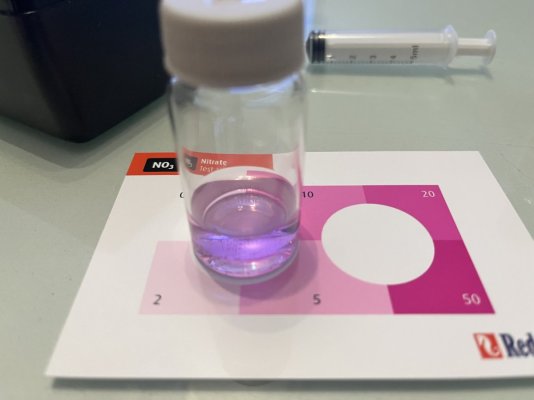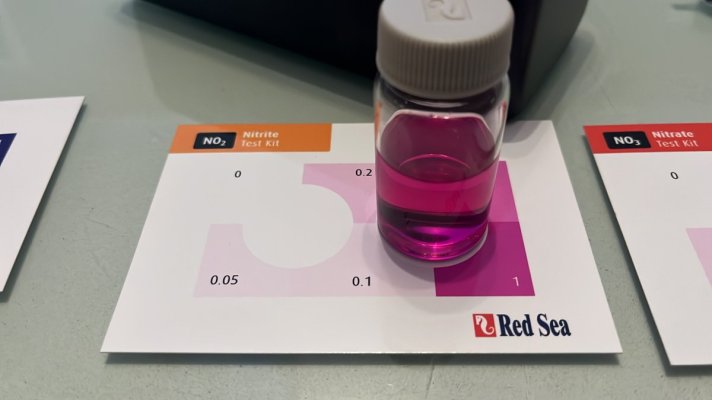It’s a 240lWhere they're actually at on the sides is up to you. What size tank is this? Flow as mentioned is something you'll have to tinker with. I'm just helping as you dip your toe in the water.
Navigation
Install the app
How to install the app on iOS
Follow along with the video below to see how to install our site as a web app on your home screen.
Note: This feature may not be available in some browsers.
More options
You are using an out of date browser. It may not display this or other websites correctly.
You should upgrade or use an alternative browser.
You should upgrade or use an alternative browser.
Is this cycle going ok?
- Thread starter deepsynth
- Start date
- Tagged users None
Jekyl
GSP is the devil and clowns are bad pets
View BadgesHospitality Award
Midwest Reefer
Fish Medic
This, plus one more of the same WaveMaker is what I would use. You only need 1 controller to operate both.
This, plus one more of the same WaveMaker is what I would use. You only need 1 controller to operate both.
Oh ok. So basically the controller is just a speed knob
Jekyl
GSP is the devil and clowns are bad pets
View BadgesHospitality Award
Midwest Reefer
Fish Medic
There's more settings than that. All sorts of varying pulses and modes along with speed and duration control.Oh ok. So basically the controller is just a speed knob
So you think running a canister is fine for now. For max 4 fishThere's more settings than that. All sorts of varying pulses and modes along with speed and duration control.
Jekyl
GSP is the devil and clowns are bad pets
View BadgesHospitality Award
Midwest Reefer
Fish Medic
I haven't used a canister so can't speak on it. Just know you should keep up with maintenance on it.So you think running a canister is fine for now. For max 4 fish
Updates to your cycle from the realm of -updated- cycling science 2022, in contrast to old cycling science from 1999
see that first picture
this tank was fully cycled / meaning you can’t possibly control ammonia any faster or better/ when the very first spot of diatoms appeared
the tank is now 100% diatoms, but this is a firm rule of benthic visual cycling cues: any new benthic growths we can see by eye indicate a completed cycle for ammonia control. Your non digital test kits may not agree, but they’re useless in todays cycling compared to what digital meters show.
you are done cycling, and into reefing choices now. Waiting longer can’t make your tank safer for fish. Nitrite no longer has any bearing in reef cycling. You don’t need to dose ammonia, test anything for cycling (non digital kits make you think a done cycle is only partially ready) this cycle is done.
if this was a seneye charted cycle, we’d clearly see the coincidence between ammonia control and the first new growth of algae, cyano or diatoms.
you don’t need the whole tank covered to know the cycle is done, any rocks that sat in water long enough for a spot to form indicate all the rocks in the contact time are equally able to control ammonia.
there are no cycles on this entire site that aren’t done. This seems crazy I know to the masses and so did pico reefs seem crazy to the masses in 2001, before reef tank size rules also got updated.
and so did pico reefs seem crazy to the masses in 2001, before reef tank size rules also got updated.
for study exercise, anyone feel free to go find someone’s new tank seneye cycle and post their logs. Let’s see how long it took after one day for ammonia to drop after using bottle bac or live rock.
see that first picture
this tank was fully cycled / meaning you can’t possibly control ammonia any faster or better/ when the very first spot of diatoms appeared
the tank is now 100% diatoms, but this is a firm rule of benthic visual cycling cues: any new benthic growths we can see by eye indicate a completed cycle for ammonia control. Your non digital test kits may not agree, but they’re useless in todays cycling compared to what digital meters show.
you are done cycling, and into reefing choices now. Waiting longer can’t make your tank safer for fish. Nitrite no longer has any bearing in reef cycling. You don’t need to dose ammonia, test anything for cycling (non digital kits make you think a done cycle is only partially ready) this cycle is done.
if this was a seneye charted cycle, we’d clearly see the coincidence between ammonia control and the first new growth of algae, cyano or diatoms.
you don’t need the whole tank covered to know the cycle is done, any rocks that sat in water long enough for a spot to form indicate all the rocks in the contact time are equally able to control ammonia.
there are no cycles on this entire site that aren’t done. This seems crazy I know to the masses
for study exercise, anyone feel free to go find someone’s new tank seneye cycle and post their logs. Let’s see how long it took after one day for ammonia to drop after using bottle bac or live rock.
Any cycle on any reef forum that seems 50% done is actually done and they’re getting ripped off thinking nh4 should be zero to be ready. reef tanks don’t run at zero ammonia / that’s old info
it is time to choose how clean you want to run the tank and how you want to begin fish disease preps. The whole reason we use updated cycling science is to prepare for certain fish disease coming if we don’t prep for it; old cycling science misleads about ammonia control and says a tank is ready for fish when ammonia and nitrite are zero, and it never discusses fish disease at all. A tank is ready for fish after you run fallow and qt preps for the animals that it can carry once any visual benthic cue is in place.
Not every tank gets these growths and can still be cycled anyway, but if a tank happens to get one of the marker growths it is certainly ready.
see any cycling charts ammonia line…how many days is it on all charts? (Ten days)
it takes longer than ten days to produce these growths…and when the growths are imported on other live rocks they can appear within ten days: it’s cycled due to those imported live materials anyway. There are no cycles in reefing that take longer than ten days (as tracked on seneye of course)
seneye changed cycling rules. Old cycling science simply cannot adjust to accurate ammonia testing we have now, it is fully built around the delays (one month on average) associated with Noh digital testing.
it is time to choose how clean you want to run the tank and how you want to begin fish disease preps. The whole reason we use updated cycling science is to prepare for certain fish disease coming if we don’t prep for it; old cycling science misleads about ammonia control and says a tank is ready for fish when ammonia and nitrite are zero, and it never discusses fish disease at all. A tank is ready for fish after you run fallow and qt preps for the animals that it can carry once any visual benthic cue is in place.
Not every tank gets these growths and can still be cycled anyway, but if a tank happens to get one of the marker growths it is certainly ready.
see any cycling charts ammonia line…how many days is it on all charts? (Ten days)
it takes longer than ten days to produce these growths…and when the growths are imported on other live rocks they can appear within ten days: it’s cycled due to those imported live materials anyway. There are no cycles in reefing that take longer than ten days (as tracked on seneye of course)
seneye changed cycling rules. Old cycling science simply cannot adjust to accurate ammonia testing we have now, it is fully built around the delays (one month on average) associated with Noh digital testing.
Last edited:
Wow what an awesome reply. Thank you. Honestly most of it flew over my head but I do get what you are saying.Updates to your cycle from the realm of -updated- cycling science 2022, in contrast to old cycling science from 1999
see that first picture
this tank was fully cycled / meaning you can’t possibly control ammonia any faster or better/ when the very first spot of diatoms appeared
the tank is now 100% diatoms, but this is a firm rule of benthic visual cycling cues: any new benthic growths we can see by eye indicate a completed cycle for ammonia control. Your non digital test kits may not agree, but they’re useless in todays cycling compared to what digital meters show.
you are done cycling, and into reefing choices now. Waiting longer can’t make your tank safer for fish. Nitrite no longer has any bearing in reef cycling. You don’t need to dose ammonia, test anything for cycling (non digital kits make you think a done cycle is only partially ready) this cycle is done.
if this was a seneye charted cycle, we’d clearly see the coincidence between ammonia control and the first new growth of algae, cyano or diatoms.
you don’t need the whole tank covered to know the cycle is done, any rocks that sat in water long enough for a spot to form indicate all the rocks in the contact time are equally able to control ammonia.
there are no cycles on this entire site that aren’t done. This seems crazy I know to the massesand so did pico reefs seem crazy to the masses in 2001, before reef tank size rules also got updated.
for study exercise, anyone feel free to go find someone’s new tank seneye cycle and post their logs. Let’s see how long it took after one day for ammonia to drop after using bottle bac or live rock.
Also what an awesome reply. But it again I’m not smart enough to understand your post haha.Any cycle on any reef forum that seems 50% done is actually done and they’re getting ripped off thinking nh4 should be zero to be ready. reef tanks don’t run at zero ammonia / that’s old info
it is time to choose how clean you want to run the tank and how you want to begin fish disease preps. The whole reason we use updated cycling science is to prepare for certain fish disease coming if we don’t prep for it; old cycling science lies and says a tank is ready for fish when ammonia and nitrite are zero, and it never discusses fish disease at all. A tank is ready for fish after you run fallow and qt preps for the animals that it can carry once any visual benthic cue is in place.
Not every tank gets these growths and can still be cycled anyway, but if a tank happens to get one of the marker growths it is certainly ready.
see any cycling charts ammonia line…how many days is it on all charts? (Ten days)
it takes longer than ten days to produce these growths…and when the growths are imported on other live rocks they can appear within ten days: it’s cycled due to those imported live materials anyway. There are no cycles in reefing that take longer than ten days (as tracked on seneye of course)
seneye changed cycling rules. Old cycling science simply cannot adjust to accurate ammonia testing we have now, it is fully built around the delays (one month on average) associated with Noh digital testing.
I’m guessing it’s ready for fish
The tank can carry lots of fish without burning them, it can handle waste processing. If you add fish without specific disease preps from the fish disease forum stickies, that's the risk. Delayed disease having nothing to do with cycling
Hey man. I bought a test and I’m confused how to read it.The tank can carry lots of fish without burning them, it can handle waste processing. If you add fish without specific disease preps from the fish disease forum stickies, that's the risk. Delayed disease having nothing to do with cycling
Attached pics for No2 and No3
Attachments
Nm i thought that was an ammonia kit
We don't test for nitrite any longer that's a wasted purchase/ ignore
Only old cycling science tests for nitrite
And the nitrate looks easy to read against its card. Your tank needs to be sixty days old before you factor nitrate levels. They don't affect fish carry at all
We don't test for nitrite any longer that's a wasted purchase/ ignore
Only old cycling science tests for nitrite
And the nitrate looks easy to read against its card. Your tank needs to be sixty days old before you factor nitrate levels. They don't affect fish carry at all
So the No2 is over 1Nm i thought that was an ammonia kit
We don't test for nitrite any longer that's a wasted purchase/ ignore
And the nitrate looks easy to read against its card
the No3 is 5
The ammonia 0.4
I did add some new sand in yesterday I don’t know if that effects anything
Attachments
-
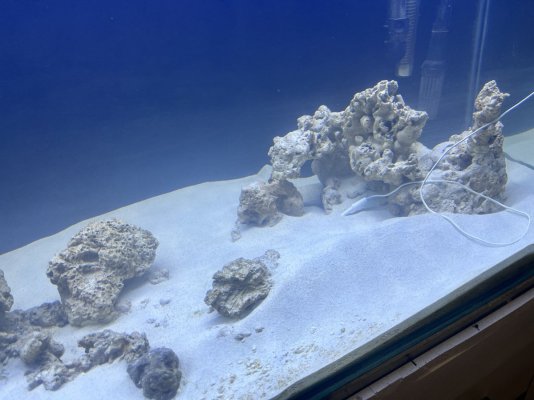 181C9AC4-F88F-407C-8D49-EFC967F0F451.jpeg163.1 KB · Views: 17
181C9AC4-F88F-407C-8D49-EFC967F0F451.jpeg163.1 KB · Views: 17 -
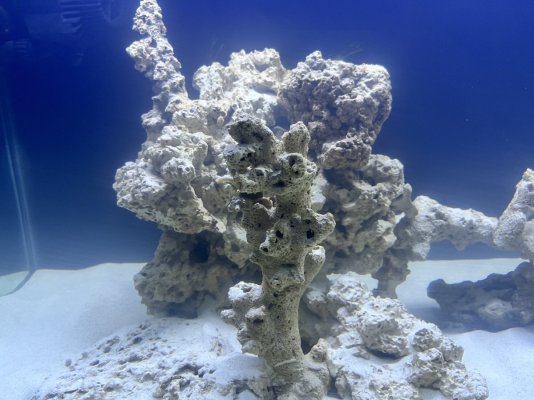 76A292CB-8030-446D-A3B1-8A1CAAD2A253.jpeg186.2 KB · Views: 23
76A292CB-8030-446D-A3B1-8A1CAAD2A253.jpeg186.2 KB · Views: 23 -
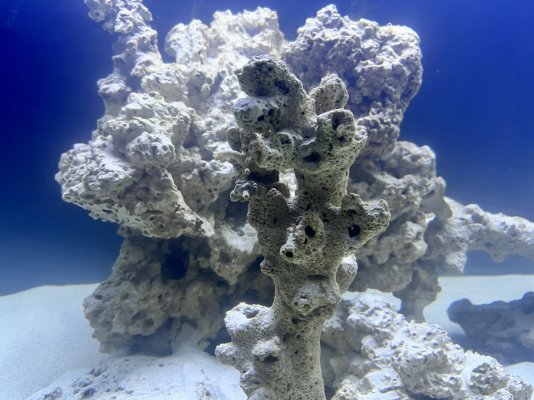 F7338327-EE90-4ACA-8A37-89BBA172DECC.jpeg191.8 KB · Views: 16
F7338327-EE90-4ACA-8A37-89BBA172DECC.jpeg191.8 KB · Views: 16 -
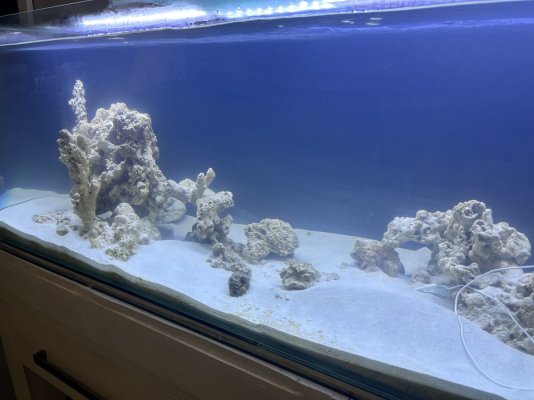 2BA5DBFC-D941-4CAD-9110-7F787A7BAC0F.jpeg152.1 KB · Views: 12
2BA5DBFC-D941-4CAD-9110-7F787A7BAC0F.jpeg152.1 KB · Views: 12 -
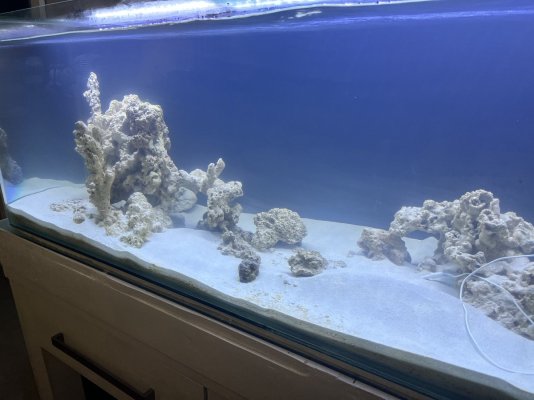 35B759CF-23C9-4F4F-8C68-77EAC53407D3.jpeg147.4 KB · Views: 18
35B759CF-23C9-4F4F-8C68-77EAC53407D3.jpeg147.4 KB · Views: 18
So the No2 is over 1Nm i thought that was an ammonia kit
We don't test for nitrite any longer that's a wasted purchase/ ignore
And the nitrate looks easy to read against its card
the No3 is 5
The ammonia 0.4
I did add some new sand in yesterday I don’t know if that effects anything
I'm going back to re read to see if you've had water and any form of feed + imported bacteria in this tank beyond ten days. one sec
we do lots of cycle tuneups it's tricky to recall each one's approach. per those good update pics above it's clearly a dry start/heading back to count # of days underwater/ compared to the ammonia drop date from a cycling chart.
we do lots of cycle tuneups it's tricky to recall each one's approach. per those good update pics above it's clearly a dry start/heading back to count # of days underwater/ compared to the ammonia drop date from a cycling chart.
findings
when I clicked to see page one and the discussion of benthic visual cycling cues I recall how well your cycle fits the example.
so the rule follows this way:
any tank showing that in pics is 100% cycled.
we don't test a display reef tank for ammonia, or nitrite, after cycling. this is currently underway, we would cease testing for ammonia and nitrite any further, for the life of the tank. it removes two worries permanently from your toolset. it also removes two, of three guesstimate feel-good-only test kits from the tool set.
temp and salinity are friendlies, they get to stay.
we don't test for nitrate until you are into your second month. reason: accounts for nitrite interference and natural resolve time- the nitrite line from a cycling chart is what we reference. we're waiting double that time
then if you want to test for nitrate you can
so you'd now suspend ammonia testing and nitrite testing permanently
and base all your upcoming reef decisions (you are past cycling decisions) on things other than ammonia and nitrite. don't base any decisions on nitrate until the tank is beyond sixty days old, then you're free to choose to be a high or low nitrate guesstimate system without harm. Paul B's reef tank hits 160 nitrate...that's higher end. nice corals.
thousands of tanks strive for 5 nitrates
nice corals
it doesn't matter what you do with nitrate in the end. I never tested for it ever, don't own the kit. keep any coral no problem. except for capnella lol
when I clicked to see page one and the discussion of benthic visual cycling cues I recall how well your cycle fits the example.
so the rule follows this way:
any tank showing that in pics is 100% cycled.
we don't test a display reef tank for ammonia, or nitrite, after cycling. this is currently underway, we would cease testing for ammonia and nitrite any further, for the life of the tank. it removes two worries permanently from your toolset. it also removes two, of three guesstimate feel-good-only test kits from the tool set.
temp and salinity are friendlies, they get to stay.
we don't test for nitrate until you are into your second month. reason: accounts for nitrite interference and natural resolve time- the nitrite line from a cycling chart is what we reference. we're waiting double that time
then if you want to test for nitrate you can
so you'd now suspend ammonia testing and nitrite testing permanently
and base all your upcoming reef decisions (you are past cycling decisions) on things other than ammonia and nitrite. don't base any decisions on nitrate until the tank is beyond sixty days old, then you're free to choose to be a high or low nitrate guesstimate system without harm. Paul B's reef tank hits 160 nitrate...that's higher end. nice corals.
thousands of tanks strive for 5 nitrates
nice corals
it doesn't matter what you do with nitrate in the end. I never tested for it ever, don't own the kit. keep any coral no problem. except for capnella lol
Last edited:
When I read your posts I sit there and think am I reading this correctly.findings
when I clicked to see page one and the discussion of benthic visual cycling cues I recall how well your cycle fits the example.
so the rule follows this way:
any tank showing that in pics is 100% cycled.
we don't test a display reef tank for ammonia, or nitrite, after cycling. this is currently underway, we would cease testing for ammonia and nitrite any further, for the life of the tank. it removes two worries permanently from your toolset. it also removes two, of three guesstimate feel-good-only test kits from the tool set.
temp and salinity are friendlies, they get to stay.
we don't test for nitrate until you are into your second month. reason: accounts for nitrite interference and natural resolve time- the nitrite line from a cycling chart is what we reference. we're waiting double that time
then if you want to test for nitrate you can
so you'd now suspend ammonia testing and nitrite testing permanently
and base all your upcoming reef decisions (you are past cycling decisions) on things other than ammonia and nitrite. don't base any decisions on nitrate until the tank is beyond sixty days old, then you're free to choose to be a high or low nitrate guesstimate system without harm. Paul B's reef tank hits 160 nitrate...that's higher end. nice corals.
thousands of tanks strive for 5 nitrates
nice corals
it doesn't matter what you do with nitrate in the end. I never tested for it ever, don't own the kit. keep any coral no problem. except for capnella lol
maybe I’m confused because I’m trying to use freshwater concepts on a salt tank.
from what I understand ammonia is produced from fish or food.
bacteria turns this into
nitrite is deadly to fish.
hence nitrite and ammonia should be 0 no?
nitrate is the result of the bacteria converting the nitrite to nitrate. Which is less harmful for fish. This is removed in water changes.
starting this tank I used a bottle of stability and 3 frozen prawns over the course of a week.
agreed a summary is in order!
-nitrite is indeed deadly only in freshwater, never ever in reef displays because display reefs run high salt vs low, the salt levels we keep/chloride blocks the receptor channels in marine animals that nitrite would normally burn/Randy HF has an article called nitrite in the reef tank we all cut teeth on to arrive at the distinction.
the recommend to stop testing for nitrite is only because that's a display reef tank above. you'd test for it in freshwater setups, hyposalinity holding tanks
but not ever in a display reef, bc it doesn't matter what it reads. your display reef and reefing choices will not change based on ANY reading of nitrite in a display reef tank. it allows you one less param to worry about, forego the test from here on out.
_____________________________
you are smack dab in the middle of a change in the marine aquarium side of cycling science
it's so new that about 90% of readers won't believe when I'm telling them and that's understandable. they will adhere to the old ways, which is about 30-60 days before all the test kits line up. they will then input fish because all cycling material (the stuff I'm updating) says it's safe to add fish when levels are 0/0/some degree of nitrate.
and that's understandable. they will adhere to the old ways, which is about 30-60 days before all the test kits line up. they will then input fish because all cycling material (the stuff I'm updating) says it's safe to add fish when levels are 0/0/some degree of nitrate.
those keepers will then flood Jay's disease forum next May with staggered fish disease losses by the bucketload, because old cycling science only hyperfocuses on test kits and it never talks about disease prep.
I urge you to stop testing for or concerning over any aspect of your cycle. you are underway reefing, you're past cycling and those parameters can't undo or drift out of spec. the test kits will eventually misread, causing you to take extended unneeded action; its best to cease testing for ammonia and nitrite.
your tank needs to be setup for sixty days before testing for nitrate, you have a reasonable chance of getting an accurate ballpark reading by waiting until day sixty, but not before, for reasons stated regarding nitrite interference.
per old cycling science, ammonia can drift out of spec you'd better test it routinely. you will buy bottle bac occasionally to make up for the dead bac that registered on your ammonia test kit as a spike.
per new cycling science, that is bunk junk rules written by a bottle bac seller designed to scare us all into repeat buying of bottled bacteria, and nobody in a display reef should be testing for ammonia and nitrite after a marine cycle completes because neither param can drift out of spec. 100% of all cycling efforts in 2022 and beyond must focus on disease preps, applying fallow and quarantine systems. anyone who chooses to test ammonia with digital meters knows it's never zero and that any ups and downs are expected, natural, and don't need to be tracked.
you will have to choose which method of reefing you want.
-nitrite is indeed deadly only in freshwater, never ever in reef displays because display reefs run high salt vs low, the salt levels we keep/chloride blocks the receptor channels in marine animals that nitrite would normally burn/Randy HF has an article called nitrite in the reef tank we all cut teeth on to arrive at the distinction.
the recommend to stop testing for nitrite is only because that's a display reef tank above. you'd test for it in freshwater setups, hyposalinity holding tanks
but not ever in a display reef, bc it doesn't matter what it reads. your display reef and reefing choices will not change based on ANY reading of nitrite in a display reef tank. it allows you one less param to worry about, forego the test from here on out.
_____________________________
you are smack dab in the middle of a change in the marine aquarium side of cycling science
it's so new that about 90% of readers won't believe when I'm telling them
those keepers will then flood Jay's disease forum next May with staggered fish disease losses by the bucketload, because old cycling science only hyperfocuses on test kits and it never talks about disease prep.
I urge you to stop testing for or concerning over any aspect of your cycle. you are underway reefing, you're past cycling and those parameters can't undo or drift out of spec. the test kits will eventually misread, causing you to take extended unneeded action; its best to cease testing for ammonia and nitrite.
your tank needs to be setup for sixty days before testing for nitrate, you have a reasonable chance of getting an accurate ballpark reading by waiting until day sixty, but not before, for reasons stated regarding nitrite interference.
per old cycling science, ammonia can drift out of spec you'd better test it routinely. you will buy bottle bac occasionally to make up for the dead bac that registered on your ammonia test kit as a spike.
per new cycling science, that is bunk junk rules written by a bottle bac seller designed to scare us all into repeat buying of bottled bacteria, and nobody in a display reef should be testing for ammonia and nitrite after a marine cycle completes because neither param can drift out of spec. 100% of all cycling efforts in 2022 and beyond must focus on disease preps, applying fallow and quarantine systems. anyone who chooses to test ammonia with digital meters knows it's never zero and that any ups and downs are expected, natural, and don't need to be tracked.
you will have to choose which method of reefing you want.
Similar threads
- Replies
- 3
- Views
- 63
- Replies
- 9
- Views
- 136
- Replies
- 6
- Views
- 123
- Replies
- 25
- Views
- 396
- Replies
- 3
- Views
- 146







